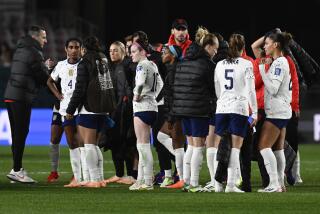Nobody Feels Neutral About Defensive Trap
- Share via
NAGANO, Japan — Just what hockey doesn’t need: more neutral zone traps.
Like it or not--and U.S. left wing Keith Tkachuk spoke for most skill players when he declared, “I hate the trap,”--the defensive tactic responsible for much of the scoring decline in the NHL the past few seasons is likely to sully the Olympic tournament. U.S. Coach Ron Wilson expects Sweden to use a version of the trap Friday, when the teams meet at Big Hat in their Olympic opener.
“It’s a defensive kind of trap,” Wilson said of Sweden’s strategy Wednesday after putting his team through a rugged, 90-minute practice. “Those guys just hang in the neutral zone and wait for you. . . .
“[Canadian Coach] Marc Crawford, his buzzword is patience, and he’s right. You have to be patient offensively and defensively. Defensively probably is more important. If you’re patient and they stay outside, at some point they have to come to you to score.”
Tkachuk agreed the U.S. must remain calm and not try to force the play against the trap.
“We’re figuring out some ways to break it,” he said. “The key is to take the chances when you get them. We’ve got some speed, so we’ve got to go to the net and crash it.”
Chicago right wing Tony Amonte, whose speed probably will be pivotal for the U.S. on the wider international rink, said the extra 15 feet in width will help the Swedes because they grew up playing on larger rinks.
“You really can’t force it, especially on the big ice. Their players are too talented and the ice is too big,” he said. “They’re just going to pass the puck around you.”
Mighty Duck winger Tomas Sandstrom, who will play on a line with Mats Lindgren and Carl Johansson, said the trap shouldn’t be a mystery to the U.S. team.
“Sweden’s been playing it for a while. All teams in North America should be used to it by now,” he said. “But it’s going to be interesting to see how everyone plays here on the big rinks. It’s a big test for all of us.”
Said King defenseman Mattias Norstrom: “When a team has total control, especially on the big rink, there’s no reason for you to run around. We’ve got good players playing the trap and we’ve got guys who can forecheck, big guys like Mats Sundin and Peter Forsberg.”
Sweden is the defending gold medalist, but the change in format from amateurs to NHL stars makes that victory almost irrelevant in this tournament. “The U.S. and Canada have got the best lineups. They’ve got stars all over the place,” said Forsberg, who put Sweden in position to win the gold at Lillehammer when he scored on Canada’s Corey Hirsch in the tiebreaking shootout. Tommy Salo then stopped Paul Kariya’s shootout attempt to clinch the medal.
“The bigger surface is going to be a bigger difference than I thought before I came here,” Forsberg added. “We’ve looked pretty good in practice and it’s always good when we get together. We get right at it, playing the U.S. and then Canada, the two favorites. That’s a good start.”
The U.S. players said they preferred to face Sweden first, trap or no trap, rather than facing one of the qualifiers who survived the opening round.
“We’d have to face them sometime, so we might as well face them now,” Phoenix center Jeremy Roenick said. “You have to have a lot of guys going more east to west than north-south. They’re tough to get around, but if you have a guy switching over three lanes and push the puck one way and move the other way with support, we’re going to be OK.”
More to Read
Go beyond the scoreboard
Get the latest on L.A.'s teams in the daily Sports Report newsletter.
You may occasionally receive promotional content from the Los Angeles Times.







